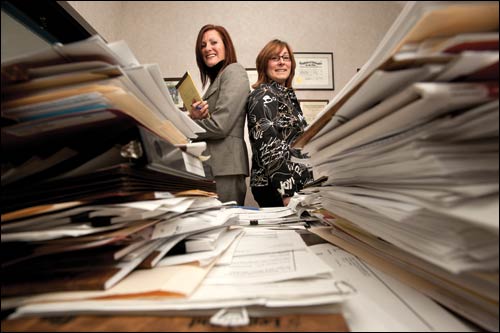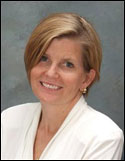Organization frustration
By: Jane Pribek//January 31, 2011//

Organization is a skill, a task and a philosophy. As Gustave Flaubert urged, “Be regular and orderly in
your life, so that you may be violent and original in your work.”
Stated another way, if you’re organized, you can utilize your time and talents to make your work product the very best it can be — as opposed to wasting time and becoming a nervous wreck over that document you cannot find within your computer that’s critical to a representation.
Here are five ways — neatly arranged, of course — to help scale the mountain of information.
Document management
Madison sole practitioner Jeffrey W. Nichols uses folders to organize his documents. The central folder is “law office,” but he also has “appeals,” “billing,” and “closed files” by year, etc. He also maintains non-client specific folders, for “templates” and “legal research.”
Within the “law office” folder, Nichols, of Nichols Law Office, arranges documents by client subfolders.
His document naming consists of the client name, matter and an abbreviation of the type of document — for example, “Jones-LTR-to client settlement.”
Markesan lawyer Mark T. Slate takes a different approach. He titles all his documents with the date it was created or received, so all documents are stored chronologically. Specifically, Slate lists the date by year, month and day; for example, Nov. 30, 2010 is “101130.”
“If you did it day, month, year, March 1, 2010 becomes 010310, which would come before Feb. 21, 2010, which becomes 210210,” said Slate, of Slate Law Offices.
Then, like Nichols, he lists the client, type of document, the initials of who created it, and a brief description of the document. So, “101115 Ltr MS mailed to client re appointment” stands for “Nov. 15, 2010, letter, by Mark Slate, to confirm an appointment.”
Another option that’s used at The Schroeder Group Attorneys at Law in Waukesha is an abbreviation of the type of document, addressee, brief description of the substance of the document, and the date as Slate lists it. For example, “L Jones confirm appt 101115” stands for “letter to Jones confirming her appointment dated Nov. 15, 2010.”
In multi-person firms, consistency across the network is crucial, said Schroeder’s chief operating officer, Sandy McGee, because if someone’s out of the office, others can access case info, plus knowledge is managed so no one is re-creating the wheel for certain documents.
Slate used a low-tech but effective method to encourage consistency, taping Post-its on all computers reminding about the uniform system.
Slate frequently uses subfolders within each client, for pleadings, correspondence, etc. McGee agreed that with voluminous files, most often litigation, subfolders are helpful.
Nichols said he doesn’t use the date as part of his naming system because Windows automatically gives the option to sort documents by date.
What’s important, all agreed, is to use a system that’s understandable, then stick to it. If you don’t like their ideas, Google “file naming conventions” and find a better system for your needs. That’s how Slate developed his, while Nichols’ is loosely based on Time Matters’ built-in document management system.
Management software/downloads
A possibility for solos is Google Desktop, a free download that lets you search your e-mail, files, music and applications.
At Schroeder, however, they determined they need a more powerful tool and have purchased iManage WorkSite for document and e-mail management, said office manager Jessica Beyer. WorkSite easily integrated with the firm’s time-and-billing software, and makes it simple to create new client workspaces, or “containers,” as they call them at her firm, so that data doesn’t need to be entered twice.
A comparable product is Worldox, said Slate, which comes highly recommended by some of the state’s legal-tech gurus. But he passed on it due to price.
VOIP phone system
Beyer said some attorneys used to have staff transcribe phone messages into files. Now that they’ve switched to a Voice Over Internet Protocol phone system, however, messages automatically appear as e-mail that can be saved to the client containers, along with the actual sound files.
Digital dictation
The Schroeder attorneys have pitched the recorders, tapes and batteries, and now dictate using BigHand digital dictation, recording directly to the client container. An assistant might need to proof the dictation initially, but as the software becomes accustomed to the speaker’s voice, errors decrease.
Attitudes
In the end it all comes down to people rather than technology. McGee and Beyer agreed that getting “buy-in” is the most important aspect of getting organized. That means firm leaders need to set the example.
Also, training needs to be made a part of the workday when new technologies are adopted, followed by periodic, informal training such as short “tips and tricks” e-mails on how to utilize a product to its best potential for each individual.
Legal News
- FBI launches criminal investigation into Key Bridge collapse
- Man charged in slaying after woman’s leg found at Milwaukee-area park
- Minnesota man guilty in fatal stabbing of teen on Wisconsin river, jury finds
- Wisconsin teen sentenced in bonfire explosion that burned at least 17
- Wisconsin man who broke into home, ate victim’s chicken, slept in victim’s bed, receives prison and jail sentences
- Judge refuses to dismiss Hunter Biden’s gun case
- House passes reauthorization of key US surveillance program after days of upheaval over changes
- Milwaukee Police officer traveling to Georgia training retires before facing discipline
- Evers to ask legislature to approve largest increase in state support for UW System in two decades
- 7th Circuit Court of Appeals proposes new rules
- Federal agencies allege toxic work environment for women in new report
- Wisconsin man sentenced for sex trafficking a woman and a minor online
WLJ People
- Power 30 Personal Injury Attorneys – Russell Nicolet
- Power 30 Personal Injury Attorneys – Benjamin Nicolet
- Power 30 Personal Injury Attorneys – Dustin T. Woehl
- Power 30 Personal Injury Attorneys – Katherine Metzger
- Power 30 Personal Injury Attorneys – Joseph Ryan
- Power 30 Personal Injury Attorneys – James M. Ryan
- Power 30 Personal Injury Attorneys – Dana Wachs
- Power 30 Personal Injury Attorneys – Mark L. Thomsen
- Power 30 Personal Injury Attorneys – Matthew Lein
- Power 30 Personal Injury Attorneys – Jeffrey A. Pitman
- Power 30 Personal Injury Attorneys – William Pemberton
- Power 30 Personal Injury Attorneys – Howard S. Sicula






